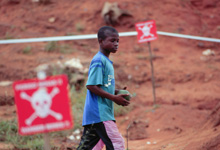Demining Malanje
A Report by Ken O’Connell
An interesting demining project
Officially MgM started the demining project in Malanje in May 2012, but problems with certification with the Provincial Authorities meant that work "on the ground" didn't actually start until the beginning of December 2012. This Project was due to last 18 months, but to allow MgM to meet deadlines, the project was extended to 25 months, with a no-cost extension by the donor. This allowed MgM to conclude the contract with the European Union, with 100% of allocated demining tasks completed.
 Pasqual Domingos, Field Team Supervisor, gives a briefing of the demining activities carried out around Kalandula
Pasqual Domingos, Field Team Supervisor, gives a briefing of the demining activities carried out around Kalandula
This was the first time that MgM had been involved in demining in the province of Malanje, although Management had previously visited the province on occasions. Little demining outside the City of Malanje occurred before peace in Angola, in 2002. Since then, the Landmine Impact Survey was conducted throughout the Province in 2006, this showed that there are165 Suspected Hazardous Areas.
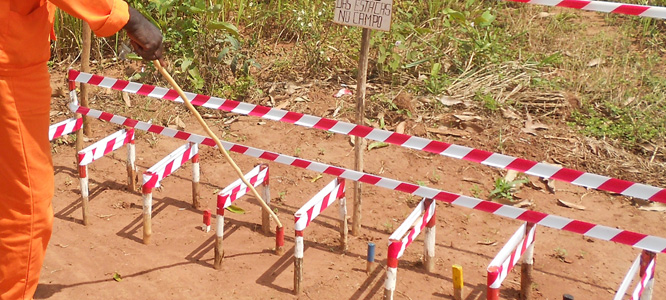 MgM uses different colours at the tops of the wooden stakes, since delineating safe and unsafe areas, and marking different classification of mines and scrap.
MgM uses different colours at the tops of the wooden stakes, since delineating safe and unsafe areas, and marking different classification of mines and scrap.
MgM were asked to assist in the demining of this Province with EU funding, by removing at least 10% of these hazardous area, with the highest priorities and impact. These were the ones with the perceived greatest threat to the lives of the families who needed to return to their homes. Normally MgM carries out integrated demining projects, demining roads to create safe access to towns and villages, then making those towns and villages, along with surround areas (farmland, water sources, etc.) safe for habitation. It was obvious that Malanje did not suffer from mined roads, as found in other provinces MgM has carried out demining operations (Bengo, Kwanza Sul, Kwanza Norte, Huíla, Kunene and Kuando Kubango). So MgM prioritized demining utilizing Manual Demining Teams supported by specialist trained Residual Explosive Detecting Dogs.
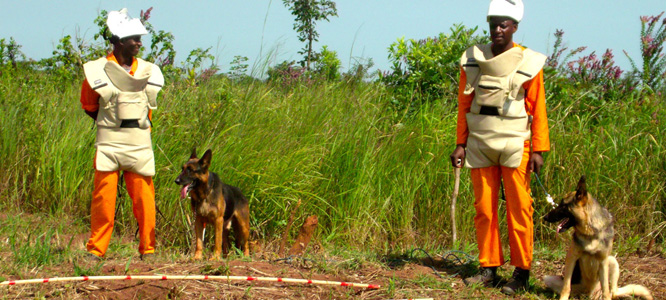 Handlers preparing their dogs before checking the areas prepared by the Mulcher
Handlers preparing their dogs before checking the areas prepared by the Mulcher
To assist the Dogs MgM also deployed an armoured Mulcher vehicle, this cuts the bush and grass to allow the dogs to check for mines, and other explosive devices.
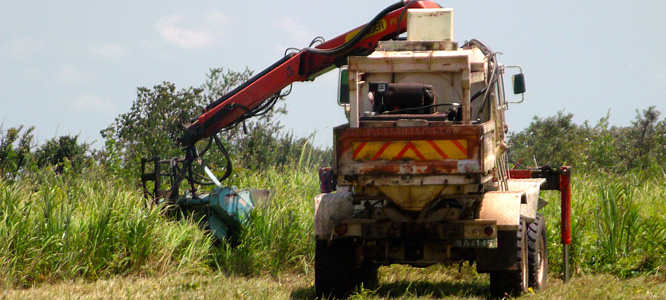 This is MgM’s bush cutting machine, the “Mulcher”.
This is MgM’s bush cutting machine, the “Mulcher”.
New perspectives for the people in Malanje
MgM's Demining Teams removed all the Suspected Hazardous Area from around the towns of Kalandula and Lombe, to the west of Malanje City, and around Kiwaba Nzoji to the north of the city. As tasks were concluded, it was nice to see the land, that MgM demined, was immediately being ploughed or prepared for construction as soon as it because available. This certainly showed that the land was in desperate need.
Tourism is a big draw for this province, with a number of National Parks providing the last known habitats for the Palanca Negra (Giant Sable), the National Symbol of Angola. Kiwaba Nzoji lies at the access to the Milando Special Reserve, removing the threats will allow this town to develop as a stop-over destination for tourists. Kalendula is famous for its waterfall, now tourists are safe to visit and walk around this wonder of nature.
On the last days in Kalandula, MgM met tourists from South Africa, who were camping close to the falls. It was nice to meet foreign tourists who had recently heard that it was safe to visit the area.
 What many people come to Kalandula for, the magnificent waterfalls. Making Kalandula safe will now give the local population impetus to start eco-tourism, and encourage more visitors to the falls and the town. This will aid in the future development of the area.
What many people come to Kalandula for, the magnificent waterfalls. Making Kalandula safe will now give the local population impetus to start eco-tourism, and encourage more visitors to the falls and the town. This will aid in the future development of the area.
Trust in MGM demining
People, who live with the threat of explosive remnants of war day in and day out, show little fear of the potential threats. Children need to be constantly reminded by their teachers at school and village leaders to be careful where they play. The adults see land in front of them that is verdant, and they are not able to send their cattle to graze. So when MgM start work people are curious and grateful at the same time. The Demining Supervisor has to give periodic updates with regards to the progress of the work, so people don't think all the land is safe until MgM are finished their demining activities. Also, the beneficiaries have to be "kept in the loop" with the progress of demining so they do not become impatient with the perceived lack of progress.
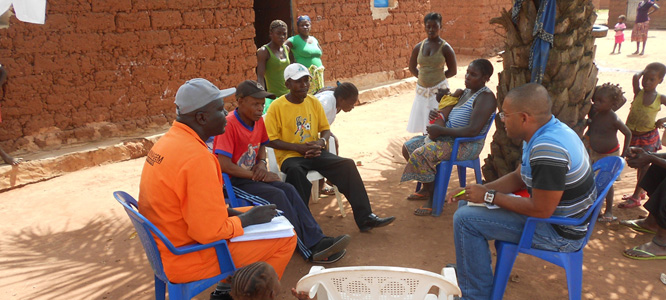 Pasqual Domingos (MgM) and Sr. Aniseto Mário (ROM) visit local villages chiefs to discuss the effects and benefits of MgM’s work on local communites.
Pasqual Domingos (MgM) and Sr. Aniseto Mário (ROM) visit local villages chiefs to discuss the effects and benefits of MgM’s work on local communites.
Manual demining is a slow and methodical process that does take time. MgM did speed up the process with the use of dogs and mechanical support, allowing land to be released by Area Reduction procedures. Area Reduction is used to reduce the area the deminers need to work in, while proving all area away from mine rows to be free of any threat.
Developing trust, you have to realise that people who have recently come out of a very long civil conflict, and they do retain some suspicion. MgM has found that the longer the team stays in one place, and the local population see that the demining is being carried out to help them, they do come forward with assistance. In some cases this will be with by revealing arms caches. Or it may be by showing buried ordnance they have hidden from their children, to stop them playing with these dangerous items. The parents are well aware that many children in the countryside have been killed and badly wounded by shiny objects lying in the long grass.
Demining results
Obviously the most important figures are those of the area cleared. In total, MgM demined 238,706 m2 in Malanje. More important is the area released. There were four Suspected Hazardous Areas listed around Kalendula, which were all relatively close to each other. By demining the hazardous areas, MgM also proved the whole of the area to the north of Kalendula to be free of any further threat.
The minefields around Kiwaba Nzoji completely surrounded the town, they prevented the re-construction and development of the town. After MgM completed their demining there, construction companies arrived to build new homes for future residents. These new residents include teachers, health workers and administration staff needed for the development of the area.
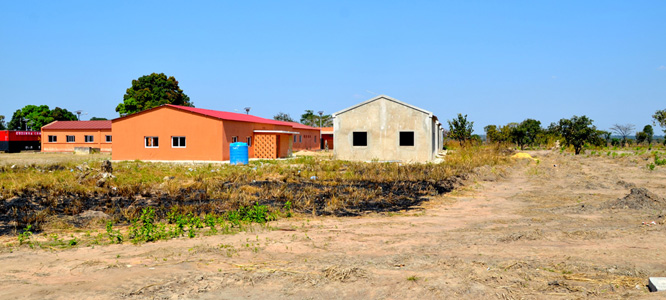 Newly constructed school, with teachers homes under-construction
Newly constructed school, with teachers homes under-construction
Now the whole town is free of mines and other explosive remnants of war. As well as new homes being built, the Catholic Church are finally able to rehabilitate the Priests and Nun's homes, which were in the middle of the minefields. In the end few mines were found, this was mainly due to unreported military Combat Engineers demining. This previous clearance was probably carried out by UNITA Sappers when they occupied the towns, to make it safe for their own military movements.
In the end only 31 anti-personnel mines and three anti-tank mines, along with 124 other explosive ordnance were removed and destroyed. Some of the minefields proved free of any hazards had no mines at all, but without official demining to prove that there are no mines left behind, nobody would use the land.
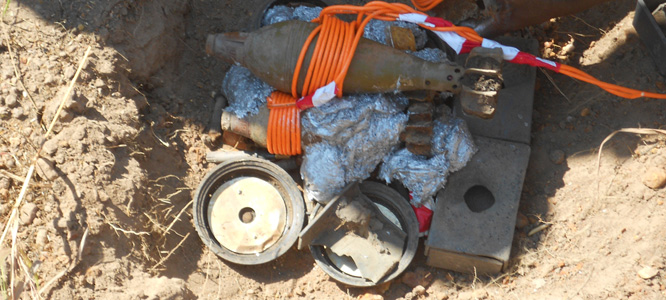 Demolition prepared, ready for the destruction of these explosive remnants of war.
Demolition prepared, ready for the destruction of these explosive remnants of war.



